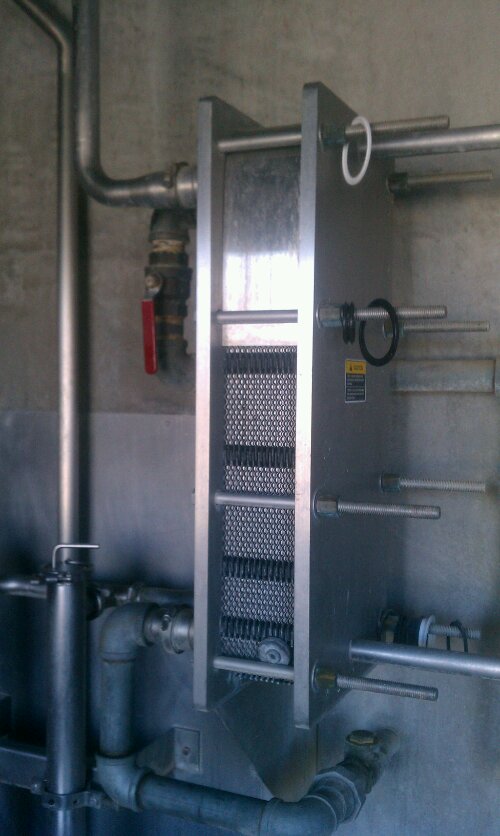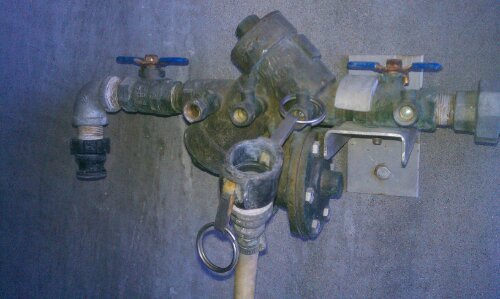Ray-Lin Dairy
raylindairy
What Cows Eat Exposed
Here is one of the ration recipe sheets we get from our dairy’s nutritionist that we use to feed our cows for their dietary needs. This single shows just five of our seven different rations for the many different groups of cows we have. We group cows based on several factors such as milk production, pregnancy, and age to make sure they receive the most nutritive feed possible and remain healthy. This sheet is similar to those found on dairies everywhere and is not unique to just our dairy and as you can see corn is just one of the many things cows eat.
Wordless Wednesday – Dairy Aerial
A few years ago a good friend took me flying and I forgot the aerial pictures I took were on my phone here is a view from the south.
Where do cows sleep?
You might wonder where cows sleep on a modern dairy farm (you might have heard them called factory farms too).
On our dairy farm cows sleep in various places.
Some of our cows sleep in freestall barns:
The stalls are cleaned daily, leveled several times a week and new bedding added every 2 weeks. Here is a bit more about making the cow beds. The cows who sleep in these barns also have access to outside corrals in the appropriate weather.
Some of our cows and younger heifers sleep in corrals:
Our pregnant cows who will be having their baby calves any day sleep on a bedded pack:
The maternity pen for the expectant cows is cleaned every day however we have to completly change the bedding several times a year. First we remove all the old bedding, then add a little sand to cover the dirt and last we add several inches of almond shells.
We also have some animals who sleep in the pasture:
Related articles
- Dairy Farm Tour! (jenhaugenrd.wordpress.com)
- Dairies pamper their cows with massages, waterbeds (cbsnews.com)
National Ag Day: Honored To Be Feeding A Growing World
Today is National Agriculture Day and we want to send thanks to everyone who supports Agriculture with the products you buy. It truly is an honor to be involved in a career that allows us to feed a growing world.
Thank You!
Here is a great Ag Day video from the folks at AdFarm:
Is my milk safe?
Cleanliness and safety is something that we think about before we even think about milking the cows. Cleanliness starts with the cow beds andalso by keeping our cows healthy . We wash our milk pipelines three times a day once between every milking shift, the milk tank is washed once a day after it has been emptied and the milk pumped out and onto the tanker truck. Food safety is something paid close attention to on a dairy farm here are few pictures showing what we do to produce healthy refreshing milk!

This tank cools the milk and stores it at a chilly 39 degrees. This is a brand new 5000 gallon milk tank we installed a few months ago.

Inside these stainless steel tubes the milk is filtered before ending up in the milk tank. Fresh new filters are installed before each milking shift.

This is a plate cooler that uses water to help cool the milk by nearly 20 degrees before the milk enters the milk tank.

This chart tracks the temperature of the milk and is changed every 48 hours. If you notice the two spikes in temperature they are when the tank is washed daily after the milk is pumped into the milk truck to be taken to the milk plant.

This sink is where the cleaning agents are m ixed with water to wash the pipelines the milk flows through. It is like a big dishwasher for pipes and is used after each milking shift.

the cows teats are dipped with an 1% iodine and lanolin solution to keep them soft and clean.

Although hard to see because it is a clear gold color this is a peroxide based teat sanitizer we use before the cow is milked. It also has lanolin in it to keep the teats soft..

The cleaning agents are automatically added to the wash sink for employee safety.

We even take safety as far as protecting our water supply from being contaminated with cleaning agents or milk.

The milking machines are washed in between every milking shift
National Cheese Lover’s Day
Hey Cheese Lover’s today is your day so vote for up to 3 of your favorite cheeses below. Feel free to add any not here.
Related articles
- celebrating National Cheese Lover’s Day on January 20 (foodtruckadventure.com)
- Artisanal Cheese Honors “National Cheese Day” With a Facebook Comment Contest to Win Affineur Collection!!! (marcellathecheesemonger.com)
- Cheese lovers. (fitfabflawless.wordpress.com)
- Top 4 Cheese Trends to Enjoy on January 20 – National Cheese Lover’s Day! (foodtruckadventure.com)
Today’s thought: Lifting the human spirit…
There’s nothing that lifts the human spirit more than making one feel like they matter for who they are…
…today I felt like I mattered when a simple blog post with a silly title was as popular as it was.
Thank you!
Cow Bling!

New calves showing off their bling!
On our farm we use eartags to give each animal an unique identifier that allows us to keep important health records for each animal. Here are a few pictures that show the tags up close.

This is used to apply the tags similar to how ears are pierced for earrings
The tags are applied in a similar fashion to earrings through a soft portion of the ear. Each tag is self contained and is clean and sterile.

Each tag has 2 parts this is the male part

Cow bling has a lot of information about the animal
The information of the tags includes our farm brand (starting at the very top of the biggest tag), next is the unique “840” number assigned to only this animal in the United States, followed by the unique number for our farm, in this case 2129. The small white tag has the same numbers and also id an EID tag that contains an RFID information. We currently do not utilize the RFID tag outside of visual use however are we will be implementing the electronic reading in the future to help with efficiency and to eliminate human error.
Peek a Boo Sun

Beautiful sunrise and one reason we enjoy working with the cows because we can witness natures grandeur first hand.
Awesome sunrise taken from one of our barns.










